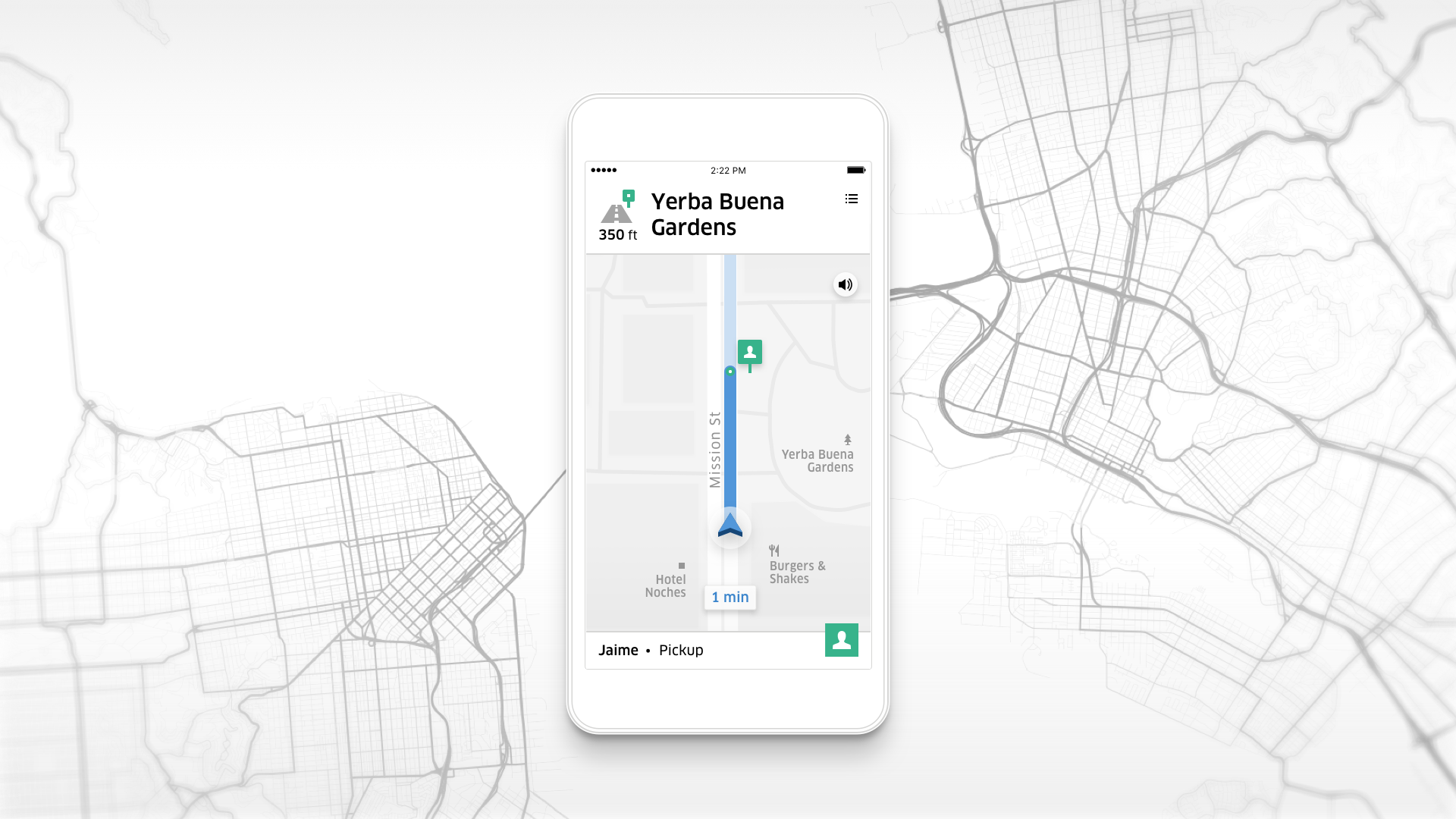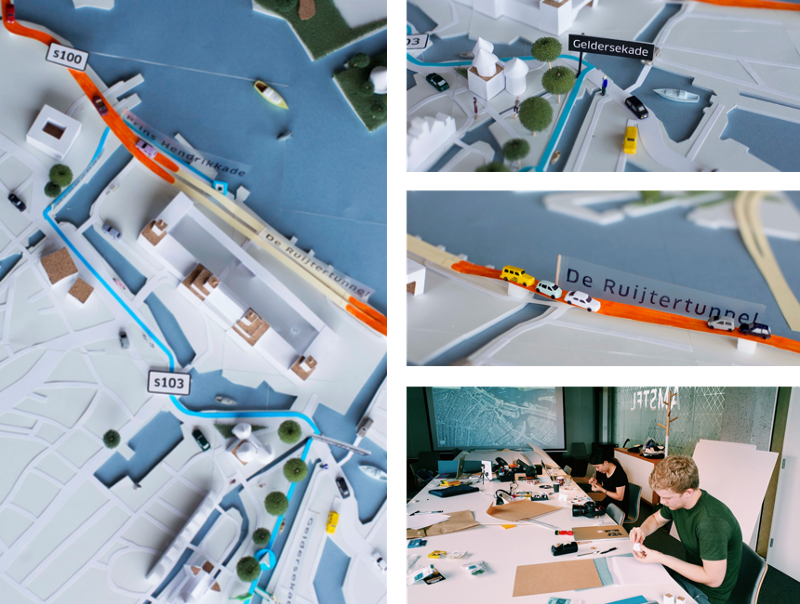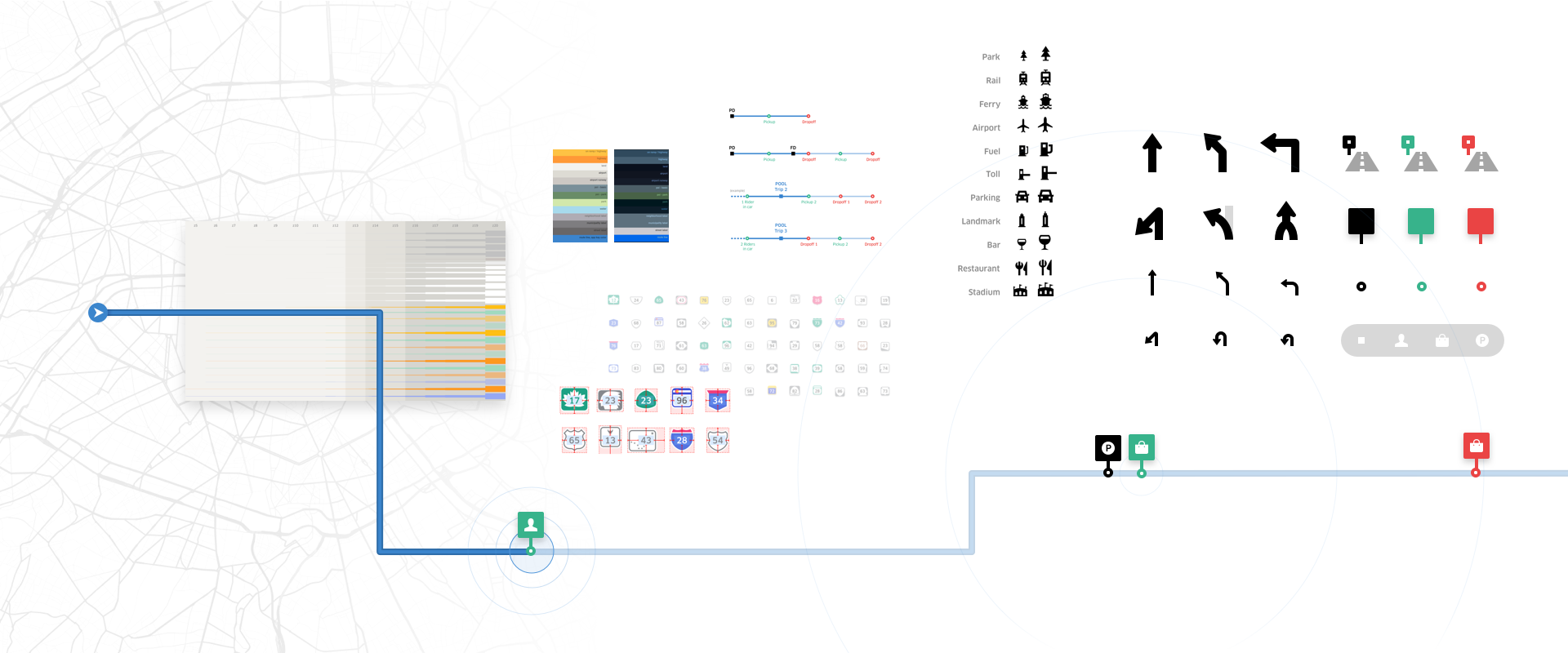How work was done to improve navigation in Uber
You are sitting in your car, listening to the rare raindrops drumming steadily on its hood. You have just completed your fourth trip in the evening and have now decided to rest. But it will not last long: the evening turned out to be troublesome. And here you are again taking an order from a passenger nearby. The navigator starts up, you fix the mirrors, start moving and drive onto the road to a new destination. Paving the way through the flow of cars, you rebuild, knowing that soon you will need to turn left. A few more traffic lights and turns - and you arrive at a busy point where the passenger is waiting for you, and are looking for a safe place to stop. A man from the crowd on the sidewalk waves and goes to you.

Now you know where you are going to go further.
')
One of the main tasks for the team working with Uber drivers is to relieve the tension from the drivers so that they can concentrate on the trip and make it safe and secure for both parties. We want to be sure that drivers can access the most useful features right from the app. And one of the most useful features is the navigation system. Therefore, we started with a simple question:
What is required from navigation when you drive from Uber?
If you are looking for a new restaurant to have lunch, or trying to find the right educational building on campus, you will not need the same map as the person who went to the mountains for a two-day excursion. And if you drive to work on a familiar daily route or to a friend's birthday party, your navigation needs will be different from the needs of people traveling with Uber. So why universal digital cards are not suitable for Uber?
It all comes down to this:

Traditional navigation and navigation in Uber
For most drivers, in most cases, the trip looks easy: you have a starting point, a destination, and the best route between them. The end.
However, if you are a Uber driver, then it all comes down to the magic moment when a car and a passenger meet. Then you go to a new destination together, and when the passenger leaves your car, you are driving to the next call. If you are a driver in the UberPool program, your route may include several points of embarkation and disembarkation at once. Add delivery to this — in this case, you may have to park and go into a building to pick up something or pass it on — and navigation can be incredibly difficult.
Here the work is not for one night
We understood how important it is to achieve a good result when it comes to such a key aspect of the trip as navigation. Uber is able to quickly update the functionality, but when working on the restructuring of navigation, we took a much more moderate pace.

A team working with drivers conducts research and product testing.
Tuning in that the project will be long-term, we were able to immerse ourselves in the needs of drivers. We conducted interviews with drivers. We traveled with them to see and hear their pain points. We organized forums in the office and collected feedback on maps and navigation. We shared prototypes, observed how drivers interact with them, listened to what they liked and what did not. We connected the device to track the view and analyzed how the visual interaction of the driver with the environment and the screen of the device. We designed an automobile simulator in the office, which was connected to the wheel game controller, videos with typical driving scenarios and navigation prototype with integrated timekeeping. We even made a physical map of Amsterdam out of paper.

Paper Amsterdam
But we did not stop at that. We sent a team to the United States and other places in the world with navigation prototypes and cameras to see what happens when the program is launched in real conditions.
It is difficult to overestimate the value of first-person testing. We realized that we needed a map + navigation tool that would be equally useful for the Amsterdam canals and the Boston tunnels, on the clogged streets of Jakarta and in New York with one-way traffic. No matter the day in the yard or the night, uberX is or uberPOOL, the tool must always meet the unique needs of drivers.
Here are some of our discoveries.
1. What's next?
Unlike traditional navigation applications, Uber navigation is designed to help users answer the question: “What's next?”. It is important that at the moment when the driver successfully completes one trip, the navigation system has already prepared the best route for the next trip.
Uber navigation should also be able to distinguish between types of places and actions, so we have developed clear visual markers for different actions that a driver can take at different stages of the trip. Personalized cartography, icons suggesting how to maneuver, marks, pointers to the right side of the street, preview of the route line and camera animation - everything works together to clarify the route as much as possible.

2. At first glance, from the first click
We used the 3-foot-1-second rule: drivers look at a screen the size of a smartphone from a distance of about three feet, about one second. This means making information available at a glance and first click is our top priority. Designing a new type of navigation was connected with the answer to the question: “What basic information does the user need right now?” Everything else goes to the background.
As for the gesture control, we wanted the drivers to have maximum freedom in this regard, but at the same time the minimum need to interact with the device while driving. We gave the driver the ability to change the scale by stretching, but also took care to switch between the overview state and first-person navigation, or to view the destination point, it was possible by simply pressing the screen.
3. Night - time of minimalism
One of the new navigation features is the night mode. Many people drive with Uber at night, and sometimes these trips last for several hours. If you use the default day settings, your eyes will get tired of the contrast of the bright screen and the darkness outside. Night mode protects drivers from visual fatigue that would otherwise pose a real safety hazard.
For night mode, we wanted to create a muted color palette. Sitting in a dark room without windows, the designers analyzed a variety of color schemes. We were amazed at how different they looked in an unlit room compared to a regular, brightly lit conference room. We checked the options we liked the most on nightly test drives and corrected all the values until the interfaces of the guide, maps and card styles began to look harmonious.

Visual Uber navigation interface
Making the Comprehensible
Navigation Uber was created specifically for drivers, and work on it is not yet finished. Every day we collect the most interesting reviews from drivers, and when creating new versions they will be taken into account first of all. In addition, now, when the basic version of the application is ready, we have a lot of possibilities in terms of design - we can not wait to implement them all.
Although this article focused on design, we cannot fail to mention the tremendous work done by designers, engineers, researchers, and product managers. And most of all, we are grateful to the drivers for the most valuable feedback that they provided to us.

Now you know where you are going to go further.
')
One of the main tasks for the team working with Uber drivers is to relieve the tension from the drivers so that they can concentrate on the trip and make it safe and secure for both parties. We want to be sure that drivers can access the most useful features right from the app. And one of the most useful features is the navigation system. Therefore, we started with a simple question:
What is required from navigation when you drive from Uber?
If you are looking for a new restaurant to have lunch, or trying to find the right educational building on campus, you will not need the same map as the person who went to the mountains for a two-day excursion. And if you drive to work on a familiar daily route or to a friend's birthday party, your navigation needs will be different from the needs of people traveling with Uber. So why universal digital cards are not suitable for Uber?
It all comes down to this:

Traditional navigation and navigation in Uber
For most drivers, in most cases, the trip looks easy: you have a starting point, a destination, and the best route between them. The end.
However, if you are a Uber driver, then it all comes down to the magic moment when a car and a passenger meet. Then you go to a new destination together, and when the passenger leaves your car, you are driving to the next call. If you are a driver in the UberPool program, your route may include several points of embarkation and disembarkation at once. Add delivery to this — in this case, you may have to park and go into a building to pick up something or pass it on — and navigation can be incredibly difficult.
Here the work is not for one night
We understood how important it is to achieve a good result when it comes to such a key aspect of the trip as navigation. Uber is able to quickly update the functionality, but when working on the restructuring of navigation, we took a much more moderate pace.

A team working with drivers conducts research and product testing.
Tuning in that the project will be long-term, we were able to immerse ourselves in the needs of drivers. We conducted interviews with drivers. We traveled with them to see and hear their pain points. We organized forums in the office and collected feedback on maps and navigation. We shared prototypes, observed how drivers interact with them, listened to what they liked and what did not. We connected the device to track the view and analyzed how the visual interaction of the driver with the environment and the screen of the device. We designed an automobile simulator in the office, which was connected to the wheel game controller, videos with typical driving scenarios and navigation prototype with integrated timekeeping. We even made a physical map of Amsterdam out of paper.

Paper Amsterdam
But we did not stop at that. We sent a team to the United States and other places in the world with navigation prototypes and cameras to see what happens when the program is launched in real conditions.
It is difficult to overestimate the value of first-person testing. We realized that we needed a map + navigation tool that would be equally useful for the Amsterdam canals and the Boston tunnels, on the clogged streets of Jakarta and in New York with one-way traffic. No matter the day in the yard or the night, uberX is or uberPOOL, the tool must always meet the unique needs of drivers.
Here are some of our discoveries.
1. What's next?
Unlike traditional navigation applications, Uber navigation is designed to help users answer the question: “What's next?”. It is important that at the moment when the driver successfully completes one trip, the navigation system has already prepared the best route for the next trip.
Uber navigation should also be able to distinguish between types of places and actions, so we have developed clear visual markers for different actions that a driver can take at different stages of the trip. Personalized cartography, icons suggesting how to maneuver, marks, pointers to the right side of the street, preview of the route line and camera animation - everything works together to clarify the route as much as possible.

2. At first glance, from the first click
We used the 3-foot-1-second rule: drivers look at a screen the size of a smartphone from a distance of about three feet, about one second. This means making information available at a glance and first click is our top priority. Designing a new type of navigation was connected with the answer to the question: “What basic information does the user need right now?” Everything else goes to the background.
As for the gesture control, we wanted the drivers to have maximum freedom in this regard, but at the same time the minimum need to interact with the device while driving. We gave the driver the ability to change the scale by stretching, but also took care to switch between the overview state and first-person navigation, or to view the destination point, it was possible by simply pressing the screen.
3. Night - time of minimalism
One of the new navigation features is the night mode. Many people drive with Uber at night, and sometimes these trips last for several hours. If you use the default day settings, your eyes will get tired of the contrast of the bright screen and the darkness outside. Night mode protects drivers from visual fatigue that would otherwise pose a real safety hazard.
For night mode, we wanted to create a muted color palette. Sitting in a dark room without windows, the designers analyzed a variety of color schemes. We were amazed at how different they looked in an unlit room compared to a regular, brightly lit conference room. We checked the options we liked the most on nightly test drives and corrected all the values until the interfaces of the guide, maps and card styles began to look harmonious.

Visual Uber navigation interface
Making the Comprehensible
Navigation Uber was created specifically for drivers, and work on it is not yet finished. Every day we collect the most interesting reviews from drivers, and when creating new versions they will be taken into account first of all. In addition, now, when the basic version of the application is ready, we have a lot of possibilities in terms of design - we can not wait to implement them all.
Although this article focused on design, we cannot fail to mention the tremendous work done by designers, engineers, researchers, and product managers. And most of all, we are grateful to the drivers for the most valuable feedback that they provided to us.
Source: https://habr.com/ru/post/324464/
All Articles